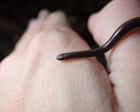
In a remarkable turn of events, the world’s smallest snake has been rediscovered in Barbados, reviving hopes for its conservation. The Barbados threadsnake, a tiny creature measuring just 10 centimeters and as thin as a strand of spaghetti, was found under a rock in the heart of the island. This rediscovery marks a significant milestone, as the snake was last documented two decades ago and was feared to be extinct.
During an ecological survey conducted in March by the Barbados environment ministry in collaboration with Re:wild, a conservation organization, this elusive species was encountered once more. The survey aimed to assess the island’s biodiversity, and the finding of the threadsnake underlines the richness and delicate balance of its ecosystem. The Barbados threadsnake is an endemic species, meaning it is unique to this region of the world. Such species are invaluable indicators of environmental health, often prompting conservation efforts due to their limited distribution and vulnerability.
The rediscovery of this miniature serpent has been met with joy and relief by biologists and conservationists globally. It shines a light on the importance of ecological surveys and habitat preservation. The threadsnake’s presence suggests that the environment can still support its life, a testament to the island’s natural resilience and the positive outcome of conservation efforts over the years. The tiny snake plays a subtle yet crucial role in its habitat, primarily feeding on the larvae of ants and termites, which helps maintain ecological balance.
For Barbados, this small reptile is a symbol of both the fragility and resilience of nature. Its rediscovery also emphasizes the necessity of ongoing conservation work. Organizations like Re:wild are at the forefront of these efforts, working tirelessly to support and protect lesser-known species that might otherwise disappear unnoticed. This discovery is a testament to their dedicated efforts and serves as an encouraging reminder that our natural world can be full of surprises.
The threadsnake’s story in Barbados is mirrored around the world, where many species face threats that challenge their survival. Habitat loss, climate change, and human activity have all contributed to the decline of countless species, necessitating a global commitment to environmental stewardship. The successful spot of the threadsnake provides hope that other species thought to be lost might still be hidden in undisturbed habitats, waiting to be rediscovered and protected.
This finding also highlights the importance of grassroots conservation initiatives. The local community’s involvement in preserving their natural heritage cannot be overstated. Public awareness and community participation are critical in fostering an environment where species such as the threadsnake can continue to thrive. Simple acts of conservation can lead to significant positive changes, made evident by the presence of this minute reptilian resident.
In essence, the reemergence of the Barbados threadsnake speaks to the broader significance of conservation as an ongoing dialogue between humans and nature. It exhorts a balance between development and ecological preservation, promoting practices beneficial to both our environments and the myriad forms of life they support. While the threadsnake may not grab headlines like larger animals, its survival is a crucial victory in the grand tapestry of biodiversity.
Ultimately, the rediscovery of the world’s smallest snake in Barbados serves as a beacon of hope and a gentle reminder of our shared responsibility to protect the natural world. As conservationists rejoice in this small but mighty victory, it fuels the collective motivation to continue efforts towards safeguarding all creatures, great and small, that call our planet home.
Source: {link}
